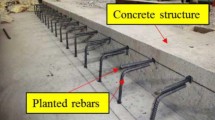Abstract
From simple strain gauges to more sophisticated techniques such as acoustic emission and digital image correlation methods, a variety of non-destructive methods are proposed in the literature for inspecting civil structures. However, in addition to accuracy and simplicity, automation and timely data collection are the main requirements for an efficient in situ non-destructive testing technique. Electrical impedance and the electromechanical impedance tests of cementitious members, are perceived to be suitable candidates for fulfilling the simplicity, automation and accuracy requirements, hence providing an efficient yet relatively non-expensive remote monitoring system. Throughout the first 28 days of a cementitious composites age, significant gain of strength is typically developed. It is crucial during this period to characterize the in situ strength gain profile for both planning and quality control purposes. This study investigates the viability of both the electromechanical impedance technique and the electrical impedance spectroscopy technique as non-destructive strength testing methods. These were assessed against their ability to detect strength changes due to the ongoing hydration reaction in cementitious mortars conforming with BS EN 196-1:2016. Results from both techniques were compared with the compressive and flexural strengths. The electromechanical impedance was assessed in terms of the change in the electrical impedance signature response through time, which was obtained through surface attached PZT sensors. Concurrently the electrical impedance response was collected through embedded stainless-steel electrodes across the frequency range of 1–10 MHz. This study will act as a guide for selection of a suitable technique for in situ strength gain monitoring using electrical methods.
Access this chapter
Tax calculation will be finalised at checkout
Purchases are for personal use only
Similar content being viewed by others
References
Gartner, E., et al.: Hydration of Portland cement. Struct. Perform. Cem. 13, 978 (2002)
Le Chatelier, H.L., Mack, J.L.: Experimental researches on the constitution of hydraulic mortars (1905)
Lim, Y.Y., Smith, S.T., Soh, C.K.: Wave propagation based monitoring of concrete curing using piezoelectric materials: review and path forward. NDT E Int. 99, 50–63 (2018)
Bickley, J.A.: Practical application of the maturity concept to determine in situ strength of concrete. Transp. Res. Record, 558 (1975)
Taha, H., Ball, R.J., Paine, K.: Sensing of damage and repair of cement mortar using electromechanical impedance. Materials 12(23), 3925 (2019)
Azhari, F.: Cement-based Sensors for Structural Health Monitoring. University of British Columbia (2008)
Su, Y.-F., et al.: Novel methodology on direct extraction of the strength information from cementitious materials using piezo-sensor based electromechanical impedance (EMI) method. Constr. Build. Mater. 259, 119848 (2020)
Taha, H., McCarter, W.J., Suryanto, B., Starrs, G.: Frequency- and time- domain dependency of electrical properties of cement-based materials during early hydration. Adv. Civil Eng. Mater. (2016)
McCarter, W.J., Brousseau, R.: The A.C. response of hardened cement paste. Cem. Concr. Res. 20(6), 891–900 (1990)
Bhalla, S., Soh, C.K.: Structural health monitoring by piezo-impedance transducers. I: modeling. J. Aerosp. Eng. 17(4), 154–165 (2004)
EN197-1:2011. In Cement: Composition, specifications and conformity criteria for common cements. London, UK, BSI (2011)
BSI, BS EN 196-1: 2016: Methods of testing cement. Determination of strength. London, UK, BSI (2005)
PI_Piezo_Technology. Piezoelectric Materials. (n.d). https://www.piceramic.com/en/products/piezoelectric-materials/#c15163. Accessed 23 May 2021
Acknowledgements
This research was funded by UK-EPSRC, grant number No. EP/P02081X/1, Resilient Materials 4 Life, RM4L. The authors gratefully acknowledge the technical staff within the Department of Architecture and Civil Engineering at the University of Bath for technical support and assistance in this work.
Author information
Authors and Affiliations
Corresponding author
Editor information
Editors and Affiliations
Rights and permissions
Copyright information
© 2023 The Author(s), under exclusive license to Springer Nature Switzerland AG
About this paper
Cite this paper
Taha, H.M., Ball, R.J., Heath, A., Paine, K. (2023). A Combined Electrical and Electromechanical Impedance Study of Early-Age Strength Gain in Cement Mortars. In: Escalante-Garcia, J.I., Castro Borges, P., Duran-Herrera, A. (eds) Proceedings of the 75th RILEM Annual Week 2021. RW 2021. RILEM Bookseries, vol 40. Springer, Cham. https://doi.org/10.1007/978-3-031-21735-7_92
Download citation
DOI: https://doi.org/10.1007/978-3-031-21735-7_92
Published:
Publisher Name: Springer, Cham
Print ISBN: 978-3-031-21734-0
Online ISBN: 978-3-031-21735-7
eBook Packages: EngineeringEngineering (R0)




